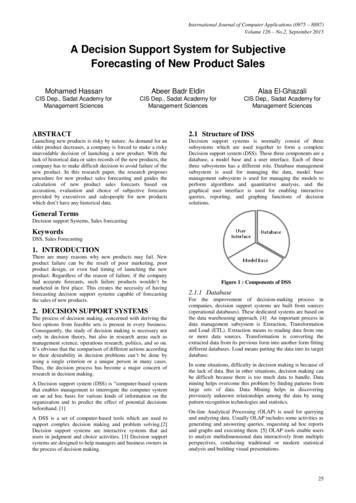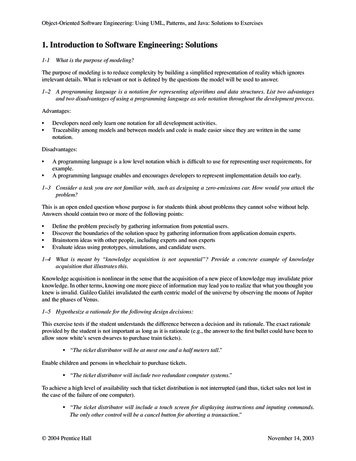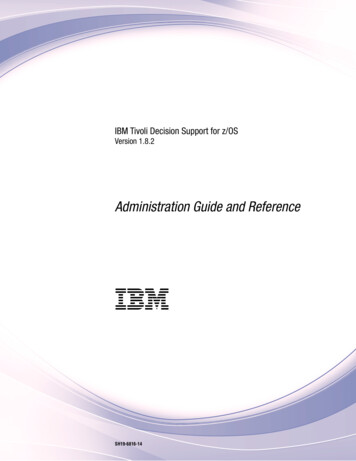
Transcription
International Journal of Computer Applications (0975 – 8887)Volume 126 – No.2, September 2015A Decision Support System for SubjectiveForecasting of New Product SalesMohamed HassanAbeer Badr EldinAlaa El-GhazaliCIS Dep., Sadat Academy forManagement SciencesCIS Dep., Sadat Academy forManagement SciencesCIS Dep., Sadat Academy forManagement SciencesABSTRACT2.1 Structure of DSSLaunching new products is risky by nature. As demand for anolder product decreases, a company is forced to make a riskyunavoidable decision of launching a new product. With thelack of historical data or sales records of the new products, thecompany has to make difficult decision to avoid failure of thenew product. In this research paper, the research proposesprocedure for new product sales forecasting and guides thecalculation of new product sales forecasts based onaccusation, evaluation and choice of subjective forecastsprovided by executives and salespeople for new productswhich don’t have any historical data.Decision support systems is normally consist of threesubsystems which are used together to form a completeDecision support system (DSS). These three components are adatabase, a model base and a user interface. Each of thesethree subsystems has a different role. Database managementsubsystem is used for managing the data, model basemanagement subsystem is used for managing the models toperform algorithms and quantitative analysis, and thegraphical user interface is used for enabling interactivequeries, reporting, and graphing functions of decisionsolutions.General TermsDecision support Systems, Sales forecastingKeywordsDSS, Sales Forecasting1. INTRODUCTIONThere are many reasons why new products may fail. Newproduct failure can be the result of poor marketing, poorproduct design, or even bad timing of launching the newproduct. Regardless of the reason of failure, if the companyhad accurate forecasts, such failure products wouldn’t bemarketed in first place. This creates the necessity of havingforecasting decision support systems capable of forecastingthe sales of new products.2. DECISION SUPPORT SYSTEMSThe process of decision making, concerned with deriving thebest options from feasible sets is present in every business.Consequently, the study of decision making is necessary notonly in decision theory, but also in research areas such asmanagement science, operations research, politics, and so on.It’s obvious that the comparison of different actions accordingto their desirability in decision problems can’t be done byusing a single criterion or a unique person in many cases.Thus, the decision process has become a major concern ofresearch in decision making.A Decision support system (DSS) is “computer-based systemthat enables management to interrogate the computer systemon an ad hoc basis for various kinds of information on theorganization and to predict the effect of potential decisionsbeforehand. [1]A DSS is a set of computer-based tools which are used tosupport complex decision making and problem solving.[2]Decision support systems are interactive systems that aidusers in judgment and choice activities. [3] Decision supportsystems are designed to help managers and business owners inthe process of decision making.Figure 1 : Components of DSS2.1.1 DatabaseFor the improvement of decision-making process incompanies, decision support systems are built from sources(operational databases). These dedicated systems are based onthe data warehousing approach. [4] An important process indata management subsystem is Extraction, Transformationand Load (ETL). Extraction means to reading data from oneor more data sources. Transformation is converting theextracted data from its previous form into another form fittingdifferent databases. Load means putting the data into its targetdatabase.In some situations, difficulty in decision making is because ofthe lack of data. But in other situations, decision making canbe difficult because there is too much data to handle. Datamining helps overcome this problem by finding patterns fromlarge sets of data. Data Mining helps in discoveringpreviously unknown relationships among the data by usingpattern recognition technologies and statistics.On-line Analytical Processing (OLAP) is used for queryingand analyzing data. Usually OLAP includes some activities asgenerating and answering queries, requesting ad hoc reportsand graphs and executing them. [5] OLAP tools enable usersto analyze multidimensional data interactively from multipleperspectives, conducting traditional or modern statisticalanalysis and building visual presentations.25
International Journal of Computer Applications (0975 – 8887)Volume 126 – No.2, September 20152.1.2 Model BaseModels use mathematical and statistical techniques todescribe the real world, and apply these models to the task athand, allowing the operator to receive recommendations orwhat-if scenarios. [6] The model management subsystemincludes all models which use mathematical techniques toperform algorithms for advanced calculations and quantitativeanalysis.These models allow the decision support system to not onlysupply information to the user but aid the user in making adecision. [7] In addition to including mathematicalcalculations and techniques, the model managementsubsystem is expanding to include business models such asEnterprise Resource Planning (ERP), Supply ChainManagement (SCM) and Customer Relationship Management(CRM) [8]. Models apply quantitative analysis andmathematical calculations to the real world tasks at hand.2.1.3 Graphical User InterfaceThe graphical user interface (GUI) is in charge for theinformation visualization. It provides the user with controlover the model management subsystem to making changes inmodel base and database, and presents desired informationand possible courses of action for the user.2.2 Types of DSSTypes of decision support systems include data driven DSS,model driven DSS, knowledge driven DSS, document drivenDSS, group DSS, function specific DSS and web based DSS.algorithms and quantitative analysis to provide help in theprocess of decision making. The main component of a ModelDriven DSS is the model-base used for providing support fordecisions which require mathematical calculations more thandata2.2.3 Knowledge-Driven DSSKnowledge-Driven DSS Sometimes described as a“Suggestion DSS” or as an “Expert System” providesrecommendations for the course of action to be taken.[6]Knowledge-driven DSS can store and apply knowledge for adifferent problems and tasks which are normally resolved by ahuman expert.2.2.4 Document-Driven DSSThis type of DSS assists in knowledge categorization,deployment, inquiry, discovery and communication. [10]Document-Driven decision support systems are used formanagement, retrieval and manipulation of unstructuredinformation in a variety of electronic formats. DocumentDriven DSS can be useful for handling documents such ascatalogues, historical documents.2.2.5 Group DSSGroup decision making involves series of interactions,communication, deliberation and other activities such asamong a group of individuals. [11] A Group Decision SupportSystem (GDSS) is “an interactive computer system. It isconducive to solving structured or semi-structured problemsby way of group decision making”. [12]Group Decision support systems support the use ofcommunications and decision models to facilitate the solutionof problems by decision-makers working together as a groupby supporting communication, document sharing and othergroup activities.2.2.6 Function-Specific DSSFunction-Specific decision support systems accomplish adecision task which is specific to the environment in whichthe DSS will be used. [6] A function Specific DSS is made tohandle a specific reoccurring task which needs to be handledregularly.2.2.7 Web-Based DSSFigure 2 : Types of DSS2.2.1 Data-Driven DSSData-Driven Decision support systems provide tools foraccess and manipulation of large databases or datawarehouses storing large amounts of data. Relationaldatabases accessed by query and retrieval tools provide a highlevel of functionality of the decision support system. A higherlevel of functionality is provided by data warehouse systemsallowing manipulation of data and online analyticalprocessing (OLAP)2.2.2 Model-Driven DSSModel-Driven DSS include computerized systems that useaccounting and financial models, representational models,and/or optimization models to assist in decision-making. [9]Model-Driven decision support systems don’t use much data.Instead, they mainly rely on using mathematical techniques,Web-Based DSS implement any of the other types of DSSwith web technologies and they become a web-basedDSS.[13] A Web-based DSS is a complex software system. Itmay integrate different data sources and related tools togenerate information to support decision-making. [14] WebBased DSSs use thin clients such as web browsers and loadprocessing to web servers which handle requests and returnthe results.3. SALES FORECASTINGSales forecasting is the activity of predicting the future levelof demand of products. It’s vital for developing salesprograms and budgets, setting up territories and evaluatingsales performance of sales people.Sales forecasting plays a significant role in making decisionsregarding new products and older products. For olderproducts, there are several quantitative methods for salesforecasting such as moving average, percent rate of change,unit rate of change, exponential smoothing and line extension.For new products, with the lack of historical data, a fewsimple routines can be employed, requiring more creativity inorder come up with useful predictions of the future level ofdemand.26
International Journal of Computer Applications (0975 – 8887)Volume 126 – No.2, September 20153.1 Product Life CycleA company wouldn’t know how the sales of a product willchange in the future from one period to the next. However, thesales of any one product to some extent will normally followthe product Life Cycle curve. A product's life cycle includesfour distinct stages such as Introduction, Growth, Majorityand Decline.[15]require replacement of business travel with communicationtechnologies such as videoconferencing.Increasingly, companies have access to multiple computermediated systems to organize business meetings. Thesemeetings have several objectives and choosing the suitablemeeting mode is considered important to effectivelyaccomplish their objectives.3.2.2 Delphi MethodUsing Delphi method, experts do not meet directly. So theywill avoid such possible negative influences within the groupsuch as, fear of the superiors, seizure of discussion from thedynamics and experts anger. [17]Figure 3 : Product Life Cycle3.1.1 LaunchDuring the first stage, Because of some conditions such astechnology limitations and high promotion costs, lowproduction output and low market recognition could persist,leading to limited sales, thin profit or maybe even loss.3.1.2 GrowthDuring the second stage, the product is accepted in the marketand sales grow rapidly. When a product has won customers’favor by technology improvement, advertisement and salespromotion, it has entered a period of growing demand.3.1.3 MaturityDuring the third stage, as the product has achieved acceptanceby most potential buyers at this stage, the sales reach peak andgrowth slows down.Numerical estimates or forecasts are made by experts in atleast two phases. The first phase is sometimes called thephases of definition and the next phases are called phases ofconvergence. The questions are about the same in each stage,but before completing the questionnaire, the opinions ofexperts are presented to their colleagues. So the questionnairemay include or exclude certain sections depending on theresults of certain phase. The moderator or the leader of thegroup processes the responses to the questionnaires. Filling ofthe questionnaire will continue at least two times and it willkeep repeating until no new estimates are occurring.4. CALCULATION OF SUBJECITVEFORECASTSTo calculate the sales forecasts of jury of executives weightsare assigned to each member of the jury based on the countand accuracy of forecasts of the member. Forecasts of eachexecutive for each product are saved in the forecast table inthe database.Table 1 : Sample of Executives’ Forecasts for Sales3.1.4 DeclineDuring the final stage, when sales fall off and profits stop.Any product would one day face its end: being eliminated bythe market. When a product cannot meet customers’ demandanymore, eventually production will stop and the product willbecome Product 1May-15145412931131Product 2May-155376477841813.2 Subjective Forecasting TechniquesProduct 3May-15630560490An important advantage of subjective techniques is that theytake into account the key personnel experience and requirelittle formal data. They can be very valuable when little or nohistorical data is available, such as for new productintroductions. [16] Subjective forecasting techniques areprocedures that turn the predictions of experienced personnelsuch as corporate executives, outside experts and salespeople,into formal forecasts.Product 1Jun-15288025602240Product 2Jun-15905480487042Product 3Jun-1511411014888Product 1Jul-15423376329Product 2Jul-151496133011633.2.1 Face-to-Face MeetingsWith the advance in technology, most business meetings canbe held virtually. However, face-to-face contact still mattersand is considered the most effective way of doing business.Face-to-Face meeting has always been believed to be the mosteffective way of contact for business. This is mainly becauseface-to-face contact enables a person to send information,give immediate feedback and generally maintain a trustworthy, personal and friendly atmosphere which could bemuch harder if done using communication technologies.Decision support systems which are facilitated for meetingsmay not apply to spatially distributed groups, which mayThe system counts the number of forecast of each member ofthe jury of executives and the accuracy of forecasts. A ratingis given to each member of the jury of executives and thenweights are assigned to members based on their ratingsTable 2 shows different possible scenarios for executives’forecasting performance. It show executives who have: High count of forecasts and high accuracyHigh count of forecasts and low accuracyAverage count of forecasts and average accuracyLow count of forecasts and high accuracyLow count of forecasts and low accuracy27
International Journal of Computer Applications (0975 – 8887)Volume 126 – No.2, September 2015Table 2 : Executives Accuracy and Count of ForecastsExecutiveIDExecutive 1Count ofForecasts1309Percentage ofTotal Count100%Accuracy ofForecasts90%Executive 21309100%80%Executive 31309100%70%Executive 41309100%50%Executive 598875.5%90%Executive 698875.5%80%Executive 798875.5%70%Executive 847836.5%95%Executive 947836.5%85%Executive 1047836.5%50%0.140.120.10.080.060.040.020Figure 5 : Executives Weights Based on AccuracyTable 4 shows assigning weights to executives based on theirpercentage of the total count of forecasts. Different weights ofexecutives depending on percentage of the total count offorecasts are shown in figure 6.Table 4 : Executives Weights Based on Percentage of TotalCount of ForecastsExecutiveIDExecutive ve68075.575.50.10258Figure 4 : Executives Accuracy and Percentage of 6.536.50.04959Executives’ ratings, which are used for assigning weights tothem can depend on accuracy, count of forecasts, or both ofthem. Table 3 shows assigning weights to executives based ontheir accuracy of forecasts. Different weights of executivesdepending on accuracy are shown in figure 0.04959Table 3 : Executives Weights Based on Accuracy0.140.12ExecutiveIDExecutive 105036.5500.065780.080.060.04Figure 6 : Executives Weights Based on Percentage ofTotal Count of Forecasts28
International Journal of Computer Applications (0975 – 8887)Volume 126 – No.2, September 2015Table 5 shows assigning weights to executives based on theiraccuracy and percentage of the total count of forecasts.Different weights of executives depending on accuracy andpercentage of the total count of forecasts are shown in figure7.Table 5 : Executives Weights Based on Accuracy andPercentage of Total Count of ForecastsExecutiveIDExecutive xecutive105036.543.250.05782Table 6 : Calculating Jury of Executives’ ForecastsExecutiveForecastWeightForecast * WeightExecutive 110500.1270133.35Executive 29400.1203113.082Executive 38200.113693.152Executive 45900.100259.118Executive 510500.1106116.13Executive 69400.103997.666Executive 78200.097279.704Executive 811100.087997.569Executive 99900.081280.388Executive 105900.057834.102Forecasted Sales904Sales force composite is an easily calculated forecastingmethod. With this procedure, forecasts are calculated byaggregating the forecasts of sales people in their ownterritories.Table 7 shows the calculation of sales force compositeforecasts by aggregating the forecasts of sales force.0.140.120.1Table 7 : Calculating Sales Force Composite ForecastsProductSalesForce 1ForecastSalesForce 2ForecastSalesForce 3ForecastSales 12000.080.060.040.020Table 8 : Different Subjective ForecastsFigure 7 : Executives Weights Based on Accuracy andPercentage of Total Count of ForecastsGiven several forecasts of several executives, the average ofgiven forecasts can be used to calculate the jury of executives’forecast. But since executives have different weights assignedto them depending on their accuracy of forecasts, count offorecasts or both, the management can use theses weights tocalculate more reliable forecasts.After calculating the subjective forecasts of the new productsales, the results are displayed for the sales management tochoose which forecasts to rely on. Table 8 shows differentsubjective forecasts displayed for sales management.Forecasting methodForecastJury of Executives Sales Forecasting1200Sales Force Composite2500Willing to buy survey results1800With no data available, depending on human skill andexperience can be the best possible way to forecast the salesof new products. A decision support system can use differentsubjective forecast of executives and salespeople to helpmanagement make more reliable forecasts. However,management still has to make important decisions using thedecision support system. Management has to choose a basisfor the evaluation of executives which changes the weightsassigned to each of them. Management also has to decidewhich forecast to rely on, jury of executives forecast, salesforce composite forecast or willing to buy results.29
International Journal of Computer Applications (0975 – 8887)Volume 126 – No.2, September 20156. REFERENCES[1] Decision Support System." McGraw-Hill Dictionary ofScientific & Technical Terms, 6E. 2003.[2] Rajib Goswami and Pankaj Barua, Web-Based DecisionSupport System: Concept and Issues, 2008[3] Marek J. Druzdzel and Roger R. Flynn, Decision SupportSystems, 2002. P794[4] Olivier Teste, Towards Conceptual MultidimensionalDesign in Decision Support Systems, 2010[5] Jinzi Gao and Ying Zhao, Decision Support Systems Research on the Application of DSS in China's Banks,2011[6] Tyler James Doan, Risky Business: Evaluation of adecision support system for use in a high riskenvironment, 2011[7] Yuri Boreisha and Oksana Myronovych, Web-BasedDecision Support Systems as Knowledge Repositoriesfor Knowledge Management Systems, 2008Figure 8 : Forecasts Received by Sales Management5. CONCLUSIONThis paper has demonstrates the decision support systems andtheir importance in new product sales forecasting.Components of decision support systems have been reviewed.Different types of decision support systems have been clearlyidentified. In addition, sales forecasting and product life cyclestages have been clearly identified. This paper shows thesubjective forecasting techniques and presents the calculationof new product sales forecasts based on subjective forecasts ofexecutives and salespeople and survey results. For the futurework the researchers intend to conduct an experiment usingdecision support systems with subjective forecasting methodsto achieve an enhancement in new product sales subjectiveforecasting. The researchers intend to apply the research onjury of executives for forecasting new product sales. This maybe a good start for new product subjective forecasting in thefuture. The future scope includes using product evaluation interms of reliability, services, operation costs and customersatisfaction and comparing them to older products to be ableto use the sales records of old products for forecasting thesales of new products. Sales records of older products andcomparison between old products and new products can beused together to increase accuracy of new product salesforecasting in the future, using quantitative methods inaddition to subjective methods.IJCATM : www.ijcaonline.org[8] Shaofeng Liu, Alex H.B. Duffy, Robert Ian Whitfieldand Iain M. Boyle, Integration of decision supportsystems to improve decision support performance, 2010[9] DJ. Power and Rahmesh Sharda, Model-driven decisionsupport systems: Concepts and research directions , 2005[10] Jai Kishore Tyagi and Pallavi Jain, An EvaluationFramework of Web- based Decision Support Systems,2014[11] Liang Chen , E-Business Adoption Research : State ofthe Art , 2013[12] Xuanhua Xu, Yue Xia, Qiufeng Wangand and HaimingZhao, Research about Group Decision Support Systemfor Technology Resources Allocation of EngineeringMachinery Based on Information Entropy, 2014[13] Daniel J. Power, Web-Based and Model-Driven DecisionSupport Systems,2000[14] Shifeng Zhang and Steve Goddard, A softwarearchitecture and framework for Web-based distributedDecision Support Systems, 2007[15] Fang Hong , Enterprise Marketing Strategy ResearchBased on Product Life Cycle , 2013[16] John T. Mentzer and Roger Gomes, Evaluating aDecision Support Forecasting System, 1989[17] Vladimir Modrak, Petre Bosun, Using the Delphi methodin forecasting tourism activity, 201430
and/or optimization models to assist in decision-making. [9] Model-Driven decision support systems don't use much data. Instead, they mainly rely on using mathematical techniques, algorithms and quantitative analysis to provide help in the process of decision making. The main component of a Model-











